There’s something about bird photography that gets the juices flowing, especially when it comes to wading and other sea birds. I admit it – I’m addicted. This addiction is driven by their beautiful colors and amazing behavior, particularly their multiple and diverse feeding patterns. The creativity and skill by which the different birds hunt can be both precise and comical.
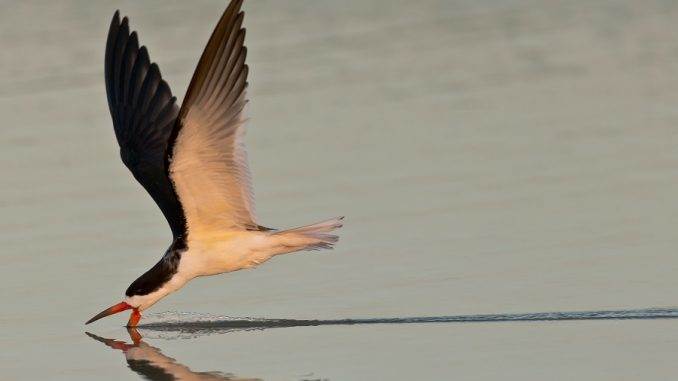
Anyone who has sat around the dinner table with a large gathering at Thanksgiving knows to be careful when reaching a hand out as they might come back with a fork stabbed in it. These feeding frenzies are not an occurrence reserved solely for people. Watching wildlife in the field can bring about these memories as some animals act like the meal they are on might be their last.
Not only is this a sight to behold but it’s also a great time for some wonderful behavior shots. Too often photographers get in a rut with wildlife, and birds in particular, of capturing beautiful portrait images but the shots with impact are those capturing some type of behavior. No behavior exemplifies this more than at feeding time.
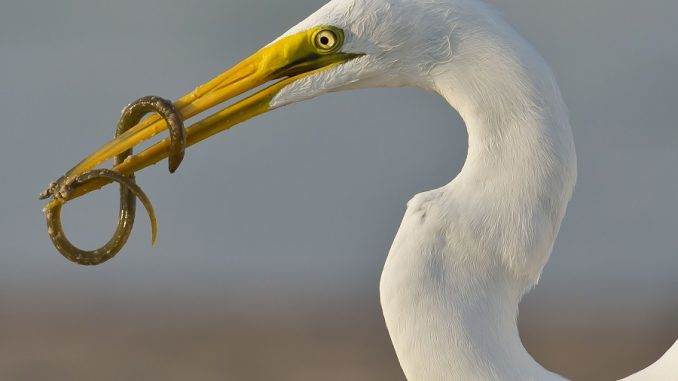
Different Birds Mean Different Behaviour
For every type of bird, there are that many different types of behavior shown when it comes to hunting or gathering food. While other images can be taken during a day of bird photography, concentrating on feeding behavior action when it starts can lead to shots where viewers will remember them more than any others.
Like most peak behavior photography, getting the right shot with feeding behavior takes a bit of practice, luck, timing, the right camera settings and knowledge of behavior.
Experienced bird photographers will say knowledge is one of the most key ingredients in the equation as it allows for getting that great shot instead of missing the action due to not knowing what’s going to happen a split second later. Watching birds over time leads to knowing what they are going to do immediately after doing something else. Knowing wading birds will always bend their knees just before taking flight is a great and easily learned tip to getting the wanted shot.
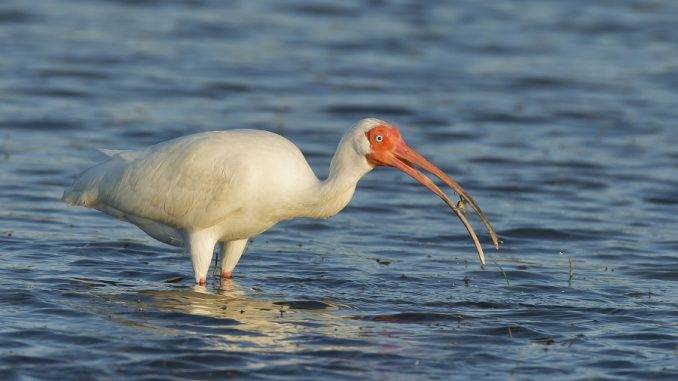
Making Sure Camera Settings Are Correct
Some camera settings need to be taken care of before approaching a shoot such as this. Most apply to all wildlife shoots but some are paramount for these quick moving subjects. Setting the Drive to high continuous is essential. No one ever wants to be out there on single shot and a great sequence takes place right after showing up and one image is taken and it’s not the peak of action.
Focus should be set to Continuous so the cameras autofocus system can anticipate and keep up with the moving subjects.
ISO should be set so as to attain a fast enough shutter speed to get the desired detail. My preference for capturing these kinds of shots is to have somewhere around 1/2000th of a second so the minute details such as water droplets or details on the prey are captured.
Depending on the light available, bumping up to 640, 800 or even higher is fine given the quality of todays cameras at handling higher ISO settings. Even on a sunny day, I typically keep the ISO at 640 knowing this almost always provides the desired shutter speeds. If the speed jumps to 1/5000th during a shoot that’s not a problem as it’s going to pick up finer details. Another thing the higher ISO allows is for stopping down a little bit for more depth of field. Shooting a f/5.8 to f/8 can be helpful for certain situations. If the bird is closer even more DOF could be used.
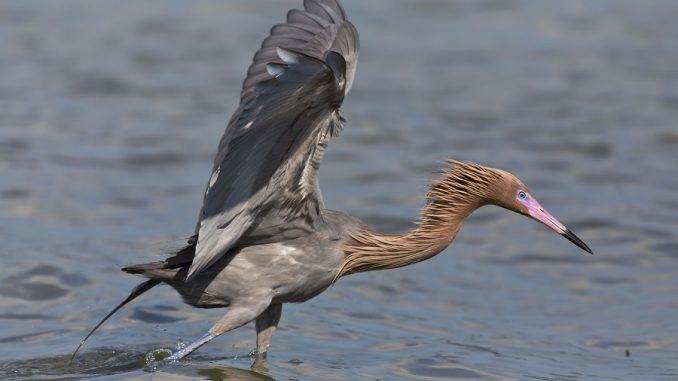
Preparing to Capture The Strike
Regarding knowing particular feeding behavior, some birds stand still like a stature waiting for something to swim by to strike, others raise their wings to put a shadow on the water just before making a strike while some will move their head and neck around like a snake and yet others will poke or shuffle their beaks / bills in the sea bed prodding for a meal.
The first style to come to mind is of wading birds standing motionless in shallow water before slowly leaning their head towards the water before making a quick strike. Green Herons take this to the extreme by clinging to reeds or branches with their heads facing down.
Reddish Egrets have the habit of creating a canopy by spreading their wings forward to create shade on the water. This allows a clearer view so they can see their prey darting around in the grass flats. By doing this, it creates wonderful shots. The other great thing with these birds is their frantic behavior as the run around all over the place looking for a meal.
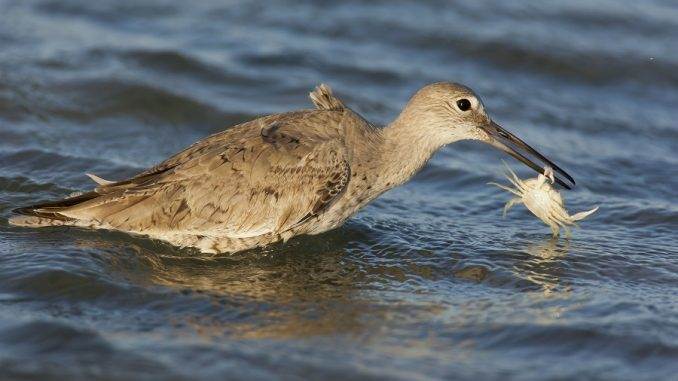
By far these are my favorite birds to photograph both because of their beautiful colors along with this unique behavior.
Little Blue Herons, snowy egrets and other smaller waders will swing their head from side to side before striking. This may be to get a better bead on their small prey to help improve their chance of a successful strike.
Willets, Tri-Colored Herons and others will shuffle their feet on the floor while continually poking their beaks into the sand to try and grab a meal. Most are trying to find small crabs or eels but sometimes they come up with tiny fish. There are times these feet shufflers are followed by other birds that will grab fish kicked up but miss by the shufflers. This is a great symbiotic relationship where the follower benefits more than the shuffler.
For spoonbills or wood storks, it’s very difficult to get shots of them with a meal as usually they are feeling, grabbing and swallowing with their bill fully under water. Getting a shot as they are lifting out of the water with droplets falling off is about as good as it gets or initial launch shots from the water, remembering to watch for them to bend their knees before taking off.
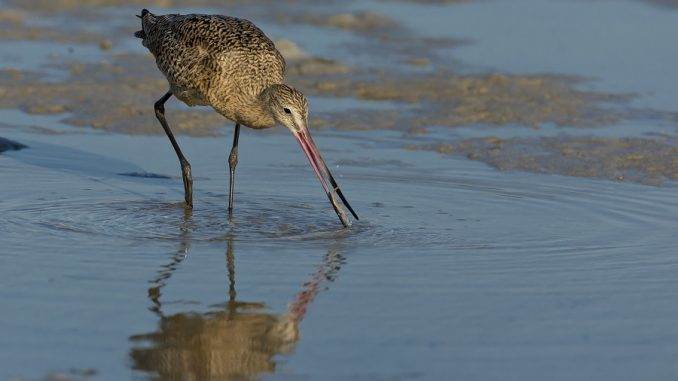
Tips For Shooting Fast Strikes
Be certain that some shots will be missed because of how fast the strikes into the water are, even with knowing the sequence of what they do first before making a strike. Quite often they come up empty as well because their prey is also fast and can be elusive, especially the small fish and shrimp many wading birds go after.
A key point to remember with wading and shore birds when they catch a meal is if the prey has its tail towards the birds’ mouth, it will need to be flipped so that it will go down headfirst. If the bird tries to swallow its meal tail first, fins, spines and other things will be spread out and can cause damage while going down as the prey does now want to give up without a fight.
Although the action is going to be very quick, try to notice which way the prey is caught in order to get a shot or two with the bird flipping the meal in its beak. Using high shutter burst is a must for this and most every other bird behavior shooting. Another key element is having a very fast shutter speed to get good detail on both the birds’ head as well as whatever it’s about to eat.
Another key element with getting a shot with certain birds flipping a meal is to keep shooting when the initial movement towards the water begins. Because the action goes so fast and might only last for a second or two maximum, start shooting as soon as the birds makes a movement for the water and continue through the whole process. There may be several deletions with getting a poor shot but anticipating there might be more than the initial shot of impact can lead to some great images.
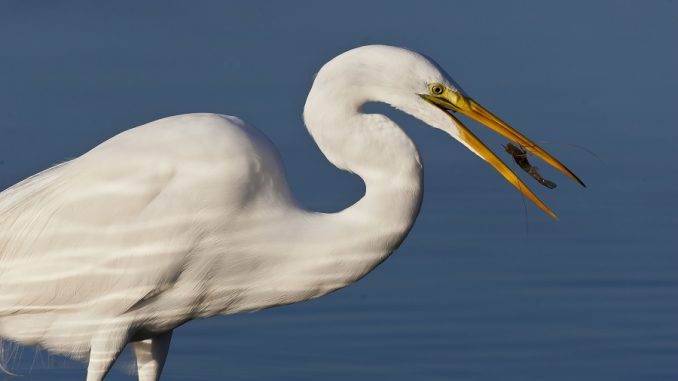
Going back to prey not giving up without a fight, some meal items such as an eel, worm or snake can put up a good fight that lasts for a bit of time as they try to wrap themselves around the beak to prevent from getting swallowed. Very rarely do they get away but it provides for some good entrainment to go along with the good shots.
The good thing about these birds and their hunt for a meal is they rarely settle for just one, allowing for numerous tries for getting the hoped for peak action shot. By staying with a feeding bird for a period of time, it helps with getting the timing down for hitting the shutter button on the initial strike. Getting the timing for this takes a bit of repetition and will not be precise the first time unless a bit of luck comes into play.
Luck occurs quite often with any action photography but most people know what Roman philosopher Seneca penned: Luck is what happens when preparation meets opportunity. The preparation here is having the proper camera settings and having the camera on the bird and the finger on the shutter button waiting for them to strike.
Some birds’ feeding behavior is more rewarding to get shots of than others. One of the better examples of this is with black skimmers. They are called skimmers for a reason as they put their elongated lower beak just into the water and skim over the water to snag small baitfish. There is no slowing down when they feel anything as they just close their beak quickly, open it back up and keep going.
While it seems like it should be easy getting a shot of these birds skimming along the water it’s not quite as simple as it might seem. This is more than just getting a bird in flight shot as they move quite quickly and sometimes change direction as they zip along the water. Timing for keeping up with them is the hardest part of this equation. Again, there will be more deletions than keeps but it should be remembered that the delete button is the best teacher.
Tides play an important role in feeding behavior. While the birds can move in and out as the shoreline changes, lagoons are best when the tide is low and the prey is trapped in the low water and the birds can move around more easily. Checking tide tables before going on a trip to find days when there are low tides near sunrise and sunset make for better opportunities. If a tide table is not available, a good time to plan a trip for cooperative tides is to pick a time around a full or new moon, as this is when the low tides are around the times of sunrise and sunset.
No matter when a trip is scheduled there will be feeding going on as they do have to keep eating, but when it’s peak high tide most of the smaller waders and shore birds will be away doing other things or taking a break as the water level is too high in their favorite feeding holes to move around.
There are even more ways these birds go about getting a meal while in the water and even with what may be in the files, there are more interesting shots to get so sit back and enjoy the show.
Article by Andy Long

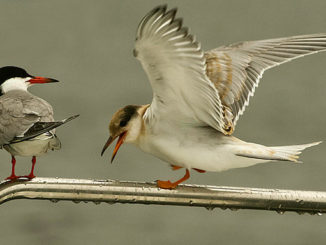
Leave a Reply